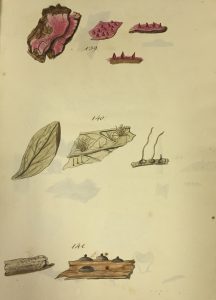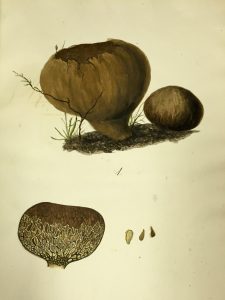
One of the newest additions to the stacks of UNC’s Rare Book Collection at Wilson Library is the unpublished manuscript fourth volume of David Lewis de Schweinitz’s Fungorum Niskiensium Icones, or Drawings of fungi. The volume was separated from a larger set of volumes and a portfolio of additional drawings, which are held by the library of the Academy of Natural Sciences of Philadelphia. Together with the four volumes and portfolio, the Wilson volume is the only extant set of this work. This leaves the question: why were these volumes separated?
The copy now housed in Wilson was originally presented to the Department of Botany through William Chambers Coker, namesake of the Coker Arboretum, on November 16, 1945. It was given by Mrs. R. F. Willingham, born Rosa Eleanor Fries, through the offices of Adelaide Fries, Rosa’s first cousin. The only mention of an author is penciled on the flyleaf, remarking that “Lewis D. de Schweinitz—Drawn and painted by him at Niesky.”

Rosa and Adelaide Fries were, in fact, the great granddaughters of de Schweinitz. This information is all noted on a typewritten page attached to the flyleaf and the donor’s name is noted on the bookplate from the botany library, where it was first shelved. How, then, was Mrs. R. F. Willingham associated with the University of North Carolina at Chapel Hill?
From a finding aid created by the library of the Academy of Natural Sciences, we know that the second, third, and fifth volumes, as well as the portfolio, were presented to the Academy in 1903 by George E. de Schweinitz, a prominent Philadelphian physician. The first volume was presented to the Academy ten years later by Emily de Schweinitz Lemly, in 1913. No other information regarding the provenance of these singular works is given.
To return to the first question of how it came to be that these volumes were separated requires first looking into the history of the de Schweinitz family, and then into the relationships of this family both with Philadelphia and North Carolina. As it turns out, there is ample information, both genealogical and published works, to help flesh out the possible answers to this question.
Lewis David de Schweinitz lived from 1780 to 1834. He was born in Bethlehem, Pennsylvania, but moved to Germany with his family at the age of 18, where he joined the Moravian Theological Seminary in Niesky. In 1805, he published together with his teacher, Professor J. B. Albertini, a work titled Conspectus Fungorum in Lusatiae superioris agro Niskiensi crescentium e methodo Persooniana, which described over a thousand fungi species. De Schweinitz then returned to the United States in 1812, to Salem, North Carolina, where he studied North Carolinian fungi and subsequently published on his observations in 1822. In 1821, De Schweinitz was transferred to Bethlehem, Pennsylvania, to take on a position as a principal at a school for girls there (Schweinitz, Gerber 205–212). De Schweinitz is considered to be the father of American mycology, the branch of biology concerned with fungi.

While the links between de Schweinitz and the institutions in which his drawings are deposited are made somewhat clear by his biography, how exactly these volumes were split up is not. After using a number of genealogical sources to do some research, it seems plausible that Lewis de Schweinitz left volumes one and four to his son Emil de Schweinitz, a Moravian minister who moved from Pennsylvania to Salem, North Carolina, to head the Salem Academy (a boarding school for girls). Emil then left volume one to his daughter Emily, who donated it to the Academy. He left volume four to his daughter Anna, who was the mother of Rosa Eleanor Fries, later Mrs. R. F. Willingham.
Another of Emil’s daughters, Agnes, was the mother of Adelaide Fries, archivist of the Moravian Church and from Salem, North Carolina. It is presumably through Adelaide’s work as an archivist that the fourth volume from Mrs. Willingham was then given to the Department of Botany at UNC. The other volumes were donated to the academy by Lewis de Schweinitz’s grandson, George, son of Edmund Alexander de Schweinitz, a prominent Moravian reverend. Due to positions with the Moravian church, members of the de Schweinitz family were constantly moving between Pennsylvania and North Carolina. Despite most of the volumes being donated to the Academy by the grandchildren of de Schweinitz, one of his grandchildren held onto her volume, passing it on to Lewis de Schweinitz’s great-granddaughter, Rosa Willingham. Likely due to the archival work of Rosa’s cousin, Adelaide, the volume then ended up in the holdings of a department of botany that represented the North Carolina roots of the family, and hence a work split between Pennsylvania and North Carolina, just as the de Schweinitz family was.

genus | Illustration number 317
This work has been digitized and can be found here, or if you want to see the beautiful watercolors in person, you can stop by the reading room in Wilson Library.
